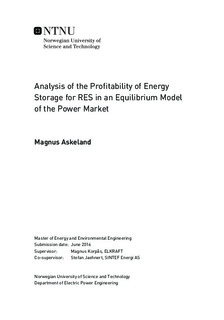Analysis of the Profitability of Energy Storage for RES in an Equilibrium Model of the Power Market
Master thesis
Permanent lenke
http://hdl.handle.net/11250/2405534Utgivelsesdato
2016Metadata
Vis full innførselSamlinger
- Institutt for elkraftteknikk [2468]
Sammendrag
The motivation behind this thesis is to utilize complementarity conditions to assessthe applications of energy storage in an energy system with high levels of renewableenergy sources. A model of a perfectly competitive power market has beendeveloped based on complementarity theory. The model includes firm demand,system operator, power producers and storage units. In addition, four differentcapacity remuneration schemes have been implemented: Energy only, strategic reserves,capacity market and capacity payment. These models have been subjectedto a scenario with high levels of renewable energy in order to assess the impact ofenergy storage in these circumstances.
The methods used in this work are theoretical and highly dependent on the assumptionsand parameters used. The documentation should give a good insightto complementarity modeling in general as well as describing the entire model allthe way up to the full mixed complementarity problem formulation.
A large part of this work has consisted of improving the existing model from theproject work and develop and integrate the energy storage with the rest of themodel.
The findings show that the system can benefit from energy storage options. Ingeneral, energy storage will give better conditions to base load units such as nuclearpower. The energy storage will smooth over variations and increase the amountof capacity a base load unit can run for a large portion of the year. UtilizingNorwegian hydro reservoirs for pumped hydro applications was found to be themost effective storage unit, increasing the amount of nuclear power by 18.8%.Pumped hydro was found to shift energy between large periods while the batterywas found to arbitrage prices on a shorter term.This thesis can give an insight into which barriers need to be overcome in order toensure investments in energy storage. For example high fixed costs of the storageand unfavorable conditions compared to thermal plants in a capacity remunerationmechanism can be the determining factor resulting in low or no installed storagecapacity.
